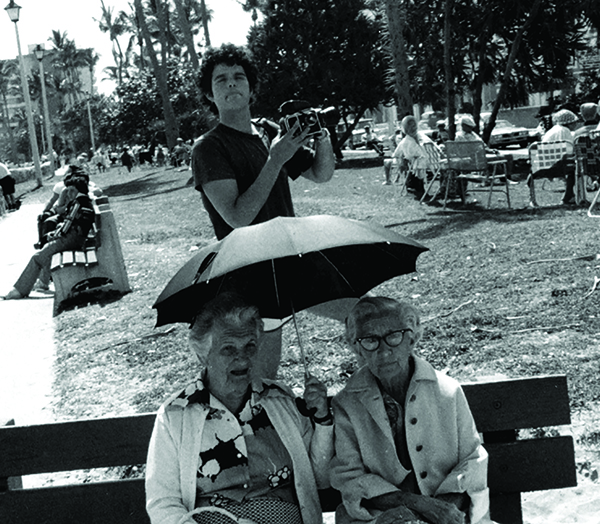Discover a bygone era of South Beach in the new exhibition “Side-by-Side in Old South Beach: Photographs by Gary Monroe and Andy Sweet,” on view at the Judi & Allan Schuman Museum Gallery at the Adolph & Rose Levis JCC’s Sandler Center in Boca Raton through February 16.
Inspired by the documentary The Last Resort, “Side-by-Side” showcases the work of two Miami Beach–born photographers who sought to depict the area’s once vibrant Jewish retirement community of the late 1970s and 1980s. It is the first time these images by Monroe and Sweet have been displayed together, notes Terri Berns, the gallery’s exhibition curator and director.

“Monroe and the late Andy Sweet so beautifully captured a time and place familiar to me and others who experienced that era on South Beach,” she explains. “Their extraordinary images are both immensely powerful and remarkably intimate—with a true sense of humanity for their subjects and their remarkable skills as photographers.”
Beyond unveiling a world few now know, this dual exhibition also provides a unique perspective into two artists’ differing approaches to the same subject. “None of us sees the world around us the same way—even if we are looking at the same thing,” continues Berns. “Monroe’s and Sweet’s works are synergistic, but when they looked at the same event or same people, there are two different realities depicted. It really adds a lot to the viewing experience to see the work, side-by-side, counterbalanced by each other.”

Throughout the show’s run, the Sandler Center will also mount “Florida Fresh Miami Beach Retrospective,” featuring talks and programs on topics related to the exhibition. Highlights include a discussion with Rabbi Paul Offenkrantz on Jackie Gleason’s impact on Miami Beach (January 23) and a review of the history of discrimination in South Florida with professor Seth Bramson (February 3).
Here, Berns goes into more detail on the exhibition and how she hopes it will impact audiences.
PBI: Monroe used black-and-white imagery, while Sweet chose instead to photograph in color. Can you talk about their different approaches?
Berns: [Neither] Gary Monroe nor Andy Sweet deliberated over their approaches; they did what came naturally. For Monroe, it was stripped-bare camera work. He used a Leica camera, whose 35-mm black-and-white film meant that he’d have nothing working for him. The small-format negatives do not yield the resolution of larger-format negatives, so he relied on gestures; indeed, he worked with fleeting gestures as part of his challenge to make the images as interesting and unpredictable as possible. Sweet utilized color film with a larger negative, and this yielded the kind of pictures that appealed to his sensibilities, with a different kind of formal challenge than Monroe’s. In all, it was a noncompetitive collaboration. Further, it yielded two distinct views of the same subject, and the complement is without equal.
Why did each photographer gravitate toward capturing this specific culture?
As natives to Miami Beach and raised Jewish, both men were primed for this. Monroe had the idea of spending a decade photographing what he realized was the endings of that old-world Jewish neighborhood, and invited Sweet to join him.

What about this era in South Beach do you feel visitors will find surprising to learn through these images?
How rich and vibrant South Beach was, how the elderly lived communally to maintain their religiosity and culture, and how it represents the endings of a lineage that goes back to the Czarist pogroms.
What aspects of Jewish life are well represented in these photographs?
While both photographers recorded aspects of daily outdoor life, Monroe especially lifted the veil to record religious mores and activities. He further visited many residents in their hotel rooms and apartments to offer a deeper look into the community.
What message do you hope this exhibition conveys to viewers?
That gone is a precious legacy, conveyed by these photographs and, otherwise, largely forgotten.









Facebook Comments